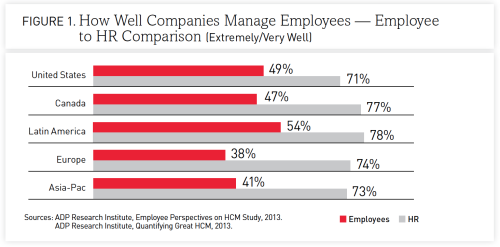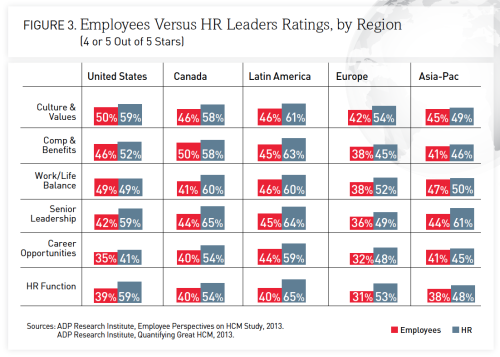ADP recently released a report which, based on data they’ve collected from several studies, examines the causes and implications of a persistent disconnect recorded between HR’s and employees’ perceptions.
The topic is an interesting one: Despite the vast improvement in and efficiency of communications tools and processes that we’ve witnessed over the years, employees and HR departments have seemed to maintain notably differing perceptions on many key human capital management effectiveness issues.
This disparity holds true globally, and in companies of all sizes. ADP has noted this trend in three of their ADP Research Institute global studies in 2013: Quantifying Great Human Capital Management, Employee Perspectives on Human Capital Management, and HR 360.
Big differences between employees and HR
All three studies measured perceptions of status and value of the HR function and showed consequential differences between employees and HR in key areas such as how well employees were being managed, how well questions regarding HR and benefits issues were addressed, whether feedback was communicated or even collected, and in performance evaluations.
The data indicates that similar gaps in perception exist between HR and senior management on these same topics, and as ADP points out, these differences matter because they may be indicative of larger problems within organizations – such as whether investments in HR technology are actually delivering the results of more effective communication, or whether advantages of a strategic HR function are being actively sought and realized.
ADP’s research studies show that globally, employees have much more negative perceptions of how well their organizations are managing them than the perceptions of their senior executives and HR leaders. This disparity is notable in such areas as compensation, work-life balance, career opportunities, and the effectiveness of senior leadership.
The data also shows that the larger the organization, the greater likelihood that employees’ perceptions of how well the organization is managed will decline.

 Executives/HR leaders are satisfied – even if employees aren’t
Executives/HR leaders are satisfied – even if employees aren’t
Senior executives and HR leaders are also significantly more satisfied than employees with the processes they have in place for getting employees’ answers to their questions regarding HR/benefits.
Globally, this disparity is greatest in the Asia-Pacific region and in the United States. In the U.S. 79 percent of HR leaders report that it is Extremely/Very Easy to get HR/benefits questions answered, compared to only 56 percent of employees.
Continuing the gap in perceptions is that, when employees’ questions are answered, HR leaders and senior executives perceive that employees are far more satisfied with the process they’ve gone through to get questions answered than employees actually are.
Such differences in perception bring to light a number of potential challenges:
- How do organizations know they’ve secured the advantages of providing benefits if HR is more fully convinced of employees’ satisfaction than employees themselves?
- Additionally, if HR thinks that their processes for answering questions are more effective than they actually are, are employees even aware of all their benefit options? This becomes especially disconcerting if organizations are counting on their benefits as a way to attract and retain talent.
Workers like having an employee portal
Interestingly, more than half of employees in large U.S. companies stated that an employee portal is an important informational resource, while less than one-third of their HR leaders shared that conclusion.
The options primarily cited by HR leaders for employees to get answers to their questions included an in-office HR team, a dedicated HR representative, and the employees’ managers. Employees’ responses however, cited an 800 number or internal company portal as the most important resources for getting answers.
Note too, that among respondents who felt that it was extremely or very easy to have their HR questions answered, less than 1 in 5 reported they would be likely to look for a new job in the next 12 months; but among respondents who said it is not easy to have their HR questions answered, that number almost doubled.
Lastly, another key area to note where disconnect occurs is between employers and employees perceptions of their organizations talent management processes:

For more on information on the disconnect between employees and human capital management, make sure to check out ADP’s full report, Human Capital Management’s Employee Disconnect. A Global Snapshot.
And, perhaps it’s time to begin questioning whether the data you are reviewing regarding your organization’s HR effectiveness is actually true.
This originally appeared on China Gorman’s blog at ChinaGorman.com.